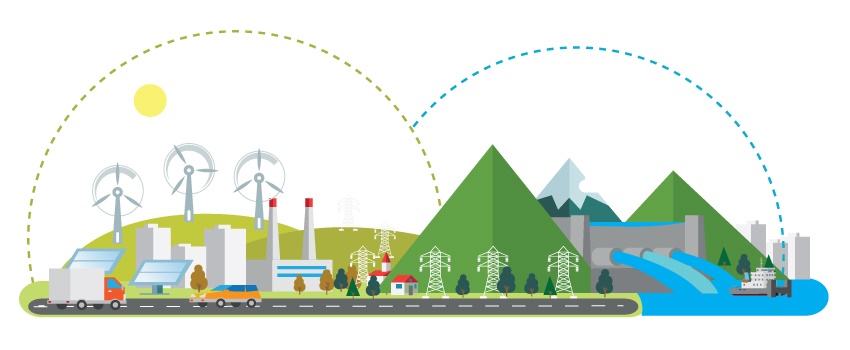Last week, OSPE’s March 2016 report Ontario’s Energy Dilemma: Reducing Emissions at an Affordable Cost, was the centre of a lively discussion on Twitter about Ontario’s energy production. We’d like to take a moment to thank everyone who shared their thoughts on the challenges and opportunities that Ontario faces with regards to reducing greenhouse gas (GHG) emissions across our economy.
In today’s blog post, Paul Acchione, P.Eng., OSPE Energy Task Force member and Subject Matter Expert, shares his insights on some of the comments and questions that we received online:
Comment:
- This is a well researched and written report. Hard on wind & solar, but maybe justifiably so. Still does not jive with Germany’s experience.
Response: Germany has a high-emissions grid. To date, their power system emissions are approximately 10 times higher than Ontario’s. Wind works with a high-emissions grid, however, it has little economic or environmental value in a low-emissions grid like Ontario’s. Because wind requires backup power sources, and natural gas is often used as the lowest-cost backup source, making room for wind generation means natural gas will operate in the base-load region of power demand. In the case of Ontario, that essentially means that you are using wind with natural gas backup as a substitute for nuclear capacity. Nuclear has essentially zero carbon dioxide (CO2) gas emissions, whereas wind with natural gas backup has emissions in the range of about 150 to 200 grams of carbon dioxide per kWh. With 84% of its energy supplied by hydroelectric and nuclear power, Ontario’s grid produces electricity at 40 grams of carbon dioxide per kWh. That means when you reduce nuclear-installed capacity in Ontario to make room for wind with natural gas backup, the emissions rise dramatically. In Germany, where there exists a high-emissions grid as a result of coal generation, the emissions drop when you displace coal capacity with wind generation. As the power system becomes cleaner, the environmental and economic value of wind generation becomes smaller.
Comments:
- You cannot ignore hydro and geothermal as baseload backups.
- Hydro and geothermal are limited in scope, whereas nuclear has no such limitation.
- Geothermal is a permanent energy source that doesn’t have the risk or refueling downtime of nuclear.
Response: In Ontario, geothermal generation and hydroelectric generation are not economically available where the load demand exists. The hydroelectric sites that do exist are too far from the load and population centres to build them economically. Geothermal storage is readily available, but the cost is high. For example, a typical home furnace and air conditioner cost about $7,000. The equivalent ground-sourced heat pump is approximately $20,000. Yes, a geothermal system uses one-quarter of the electricity, but for small residential systems with natural gas at decade-low prices, the payback period is too long to attract consumer interest.
Comment:
- The more money invested in nuclear energy, the safer and more advanced it can be made through new developments.
Response: True, but the industry needs to more effectively deal with several challenges that are of concern to the public. These include cost and schedule over-runs, long-lived radioactive waste management, nuclear weapons proliferation, radioactive releases from accidents and lack of public education on the biological effects of radioactivity.
Question:
- Why are we getting into this discussion when “green” companies are going bankrupt and projects are frequently being cancelled?
Response: Misguided policies create boom and bust cycles. Energy policies informed by careful engineering, economic analysis and simulation studies would do much to eliminate excessive business speculation and wasteful projects that chase the current “hot technology” supported by misguided policies.
Question:
- Shouldn’t Ontario be purchasing power from Manitoba and Quebec instead? Where is that assessment?
Response: The IESO website has a study on the possibility of using Quebec to supply Ontario electricity demand. The problem with this setup is that Ontario and Quebec do not have sufficient inter-tie capability, and Quebec’s hydroelectric generation capacity is not large enough to supply Ontario’s demand during peak load periods. So a question to consider – if we need to build additional generation and transmission capacity, is it better to do it in Quebec or here in Ontario?
Comment:
- Ontario’s CO2 emissions will increase when more nuclear reactors go offline for refurbishment and natural gas picks up the baseload.
Response: Yes, that is true. Ontario’s 2013 Long Term Energy Plan and the recent IESO Long Term Planning Update include the specific predictions. When the Pickering Nuclear Generating Station is retired after 2024, CO2 emissions will roughly double from Ontario’s electrical grid, compared to 2015/2016 emissions.
Question:
- How much CO2 is used in the production of wind towers? And chemicals used in the production of solar panels?
Response: There are some new studies on Energy Return on Investment (EROI). EROI essentially measures how much energy a facility produces over its lifetime, compared to the energy it takes to build the facility. The authors of some of these studies believe modern industrial societies need a minimum EROI of 7. Within the various studies, the EROI of nuclear is about 75, hydroelectric is about 50, natural gas is about 30, wind is about 16 (not including hydro storage to smooth out its variability) and solar PV is about 4 (not including hydro storage to smooth out its variability). If you add hydroelectric storage to smooth out variable renewable generation, hydroelectric drops to 35, wind drops to 4 and solar drops below 2.
Comment:
- Geothermal makes solar look good.
Response: None will be outlawed, but nuclear might take the number one spot from hydro. In Ontario, nuclear currently supplies 60% of our electricity and hydroelectric supplies 24%, so nuclear power generation is already number one here in Ontario in terms of the amount of energy supplied. This is why Ontario is one of the lowest-emitting mixed generation systems in the world. Jurisdictions with high penetration of hydroelectric and/or nuclear generation have the lowest emissions. Jurisdictions with the highest penetration of wind and solar generation have relatively high emissions, due to the need for fossil fuel backup for those sources.
Question:
- Why isn’t as much money or time spent on geothermal as solar? Should more money be spent on it?
Response: We have to be careful when we speak about geothermal. There is geothermal generation and there is geothermal storage. They are quite different. Geothermal storage for large buildings is economic in Ontario. Geothermal generation is not. There are no economic geothermal generation sites in Ontario.
Comment:
- Ground source heat pumps are a better bet for Canada.
Response: Agreed, but capital cost is still a problem for small systems for homes.
Question:
- What about Tesla’s Powerwall? Can we use those as storage?
Response: Yes, provided that the Powerwall is installed local to either the consumer or the solar panels. The cost, however, is still prohibitive. The current price, with all the parts installed (i.e.: grid qualified inverters) is about $1,000 per kWh. Storage doesn’t produce energy, it only moves energy around, so the cost of the storage has to be added to the cost of the generation. To filter a week of solar energy requires about 6 hours of storage. That means a small residential solar system at $4,000 per kW will now cost about $10,000 per kW. That effectively more than doubles the cost of solar powered electricity. If we wanted to go 100% solar year-round with no greenhouse gas emissions, we would need about 250 hours of storage and we don’t have the financial capacity in Ontario to buy such a system.
If you have any additional comments or questions about Ontario’s energy production, share your thoughts in the comments section below, or send them directly to advocacy@https://ospe.on.ca/wp-content/uploads/2024/10/academy-banner-7.png.on.ca.







Leave a Comment